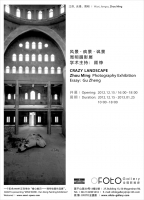CRAZY LANDSCAPE
| Retail Price: | Negotiable |
| Tel: | +86-21-62985416 |
| Address: | 2F, Building 13, 50 Moganshan Rd., Zhabei District, Shanghai |
Details
From “organic absurdity” to “inorganic absurdity”——a new thinking on Zhou Ming’s new worksGu Zheng.
This is my third time to write on Zhou Ming’s photography; so to say that at least I know a bit about his work. But through his work, I become less and less familiar with the country through his lens. And the works Zhou Ming presents in this photography exhibition are the real scenes of this country which has been changed beyond recognition for a very long time. During the rapid transition of the contemporary China’s real landscape, a combination of natural landscape and social landscape, to a “crazy landscape”, he seizes every opportunity to search for these charming and at the same time confusing landscapes and presents them to the public.
I think the most obvious change of Zhou Ming over the past more than 10 years is to present from narrative to non-narrative surreal scenes. At least I feel so. It’s not only profound change of real scenes but also definite change of photographer Zhou Ming. Meanwhile, I can feel strongly that his consciousness of the reality becomes deeper, which of course includes the deepening of the theme.
If before the earlier series SHANGHAI: AN ALTERNATIVE VIEW, the surreal scenes are mainly about humor and try to find the amazing beauty of world by presenting a certain degree of absurd scenes, the other series after SHANGHAI: AN ALTERNATIVE VIEW is rapier thrust to the impenetrable world.
In the turning point series SHANGHAI: AN ALTERNATIVE VIEW and the new exhibits, the absurd reality has profound changes. More important, the absurdity has widely changed in essence. Before SHANGHAI: AN
ALTERNATIVE VIEW, the absurdity in people’s activities is painstakingly salvaged, discovered and presented by his unique vision from the reality. Ever since SHANGHAI: AN ALTERNATIVE VIEW, a certain sense of absurdity in the photos often happens on the objects and spaces of the people’s conscious activities, such as the urban landscapes in Shanghai, as well as the present exhibits of the urban and rural landscapes all over China.



 Tel:
Tel: Address:
Address: Email:
Email: